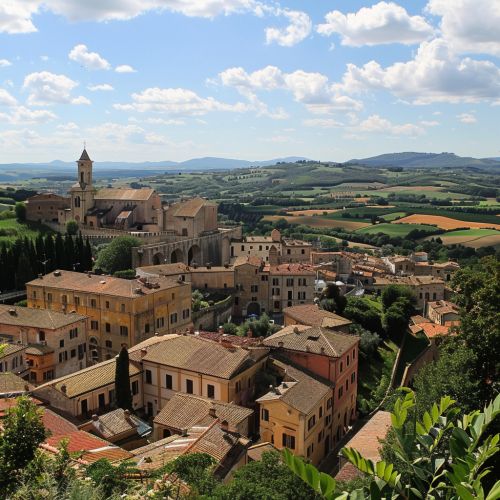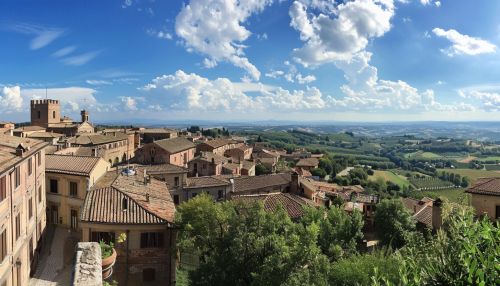Urbino
History
Urbino is a walled city in the Marche region of Italy, south-west of Pesaro, a World Heritage Site notable for a remarkable historical legacy of independent Renaissance culture, especially under the patronage of Federico da Montefeltro, duke of Urbino from 1444 to 1482. The town, nestled on a high sloping hillside, retains much of its picturesque medieval aspect. It hosts the University of Urbino, founded in 1506, and is the seat of the Archbishop of Urbino. Its best-known architectural piece is the Palazzo Ducale, rebuilt by Luciano Laurana.


The origins of Urbino are ancient, dating back to the Umbri tribe, a population that settled in the region about 1000 BC. The city of Urbino was founded in the 6th century BC by the Umbri. The Umbri were later conquered by the Etruscans, who controlled the region until the 3rd century BC when they were defeated by the Romans. Urbino became a Roman colony and was an important strategic outpost due to its location.
During the Middle Ages, Urbino grew in importance because of its strategic location, which allowed it to control the Via Flaminia, the ancient road connecting Rome to the Adriatic Sea. In the 12th century, the city became a free commune and started to expand its territories. In the 13th century, Urbino was a member of the Guelph League, an alliance of cities that supported the Pope against the Holy Roman Emperor.
In the 15th century, Urbino reached its peak of cultural and political importance under the rule of Duke Federico da Montefeltro. Federico, a patron of the arts, commissioned the construction of the Palazzo Ducale and attracted artists and scholars to his court, making Urbino a center of the Italian Renaissance.
Architecture
Urbino's architecture is a testament to the city's rich history and cultural heritage. The most iconic building in Urbino is the Palazzo Ducale, one of the most important examples of Renaissance architecture in Italy. The palace was commissioned by Duke Federico da Montefeltro in the 15th century and designed by the architect Luciano Laurana. The palace is now home to the Galleria Nazionale delle Marche, which houses one of the most important collections of Renaissance paintings in the world.
Another significant building in Urbino is the Cathedral of Urbino, a neoclassical building that was rebuilt in the 18th century after an earthquake destroyed the original 15th-century structure. The cathedral houses a number of important works of art, including a Last Supper by Federico Barocci.
The city is also home to a number of well-preserved medieval and Renaissance buildings, including the Oratory of San Giovanni Battista, which contains a series of 15th-century frescoes by the brothers Lorenzo and Jacopo Salimbeni.
Culture
Urbino has a rich cultural heritage, with a history that spans over two millennia. The city is known for its contributions to the Italian Renaissance, particularly under the patronage of Duke Federico da Montefeltro. Urbino was a center of learning and the arts during the Renaissance, attracting artists, scholars, and writers from across Italy and Europe.
The city is home to the University of Urbino, one of the oldest universities in the world, founded in 1506. The university has a long history of excellence in the humanities and social sciences, and continues to be a leading institution in these fields.
Urbino is also known for its traditional crafts, particularly ceramics. The city has a long history of ceramic production, dating back to the Middle Ages. Today, Urbino's ceramics are highly sought after for their quality and craftsmanship.
Economy
Urbino's economy is primarily based on tourism, education, and the production of traditional crafts. The city's rich cultural heritage and picturesque medieval architecture attract tourists from around the world. The University of Urbino is also a major employer in the city, with a significant number of staff and students.
The production of traditional crafts, particularly ceramics, also plays an important role in Urbino's economy. The city is known for its high-quality ceramics, which are exported internationally.
